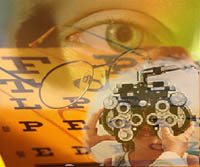This is very common. You may notice that your sight has become blurred or misty, or that your glasses seem dirty or appear scratched.
Cataracts can form at any age. Most develop as people get older but we don't yet know why, although research is being done into a number of possible causes. In younger people we know that they can result from conditions such as diabetes, certain medications and alongside other longstanding eye problems.
What treatment is available?
The most effective treatment for cataracts is an operation to remove the cloudy lens. Diets or drugs have not been shown to slow or stop the development of cataract.
When should I have the operation?
In the past, eye specialists often waited until the cataract became "ripe" and your vision was very poor before suggesting that you had the cataract removed. Nowadays, with modern surgery, the operation is usually done as soon as your eyesight interferes with your daily life and your ability to read, to work, or do the things you enjoy. You will probably want to consider surgery if this is the case.
If you are a driver you must reach the visual standard required by the Drivers and Vehicle Licensing Authority (DVLA - for details see Who Can I Contact?) and it may be necessary to have the cataract removed in order to keep your licence.
Pre-operative assessment
Before the operation, you and your eye will be carefully checked to decide the details of the operation. This may require a separate visit before the operation.
What happens in the operation?
Almost everyone has a local anaesthetic. With a local anaesthetic, you will be wide awake but feel nothing in your eye.
Usually the eye specialist will explain what is happening as the operation goes along, and someone will also be there to hold your hand if you wish, and make sure you are comfortable and relaxed. You may vaguely see some movement but no details of the operation.
If, however, you do have a general anaesthetic you will be completely unconscious, and it will be like sleeping through the operation.
The eye specialist does the operation with the aid of a microscope, through a small incision in the eye. This incision is so small that stitches are not usually necessary. The operation often takes about 15-20 minutes, although it can last longer.
During the operation the lens containing the cataract is removed and replaced with a plastic lens, so that the eye can see clearly after the operation. This plastic lens is called an intraocular lens implant and remains permanently in your eye.
A pad or shield will probably be put over your eye to protect it from accidental rubbing and bumping after the operation.
The operation cannot be performed by laser, although laser treatment is sometimes needed afterwards if the lens casing (the capsule), which is usually left in place, becomes cloudy.
We want to reassure you that your eye is not taken out of its socket during surgery. The operation is not painful and if stitches are used, they cannot be seen or felt.
After the operation
Most people notice an instant improvement in sight, although complete healing may take several months.
You will be given eye drops to use for up to two months after your operation. It is a good idea to have some help at home, especially if you find it difficult to put your eye drops in.
Most people will have the operation and go home on the same day, and will probably be able to carry on with normal daily activities - but do think about the following:
- Avoid rubbing your eye; wear an eye shield if you are a restless sleeper
- Don't do any very heavy lifting, and avoid strenuous exercise and swimming
- Take care if it is windy, in case anything blows in your eye, although you don't need to stay indoors
The eye specialist or a nurse in the eye clinic will be able to answer any questions you may have, and advise you when to have an eye check, when you can go back to work, drive and fly again.
Possible problems
Cataract surgery is one of the most successful operations. Fewer than two per cent of patients have serious, unforeseen complications. If you have any concerns after the operation ring the eye clinic or the doctor on call in the eye unit.
One of the commonest, and most easily correctable, complications is a thickening of the lens casing - the part of the eye that holds the lens in place.
As mentioned earlier, this can easily be corrected with laser treatment.
If you are worried about anything not covered in this general leaflet, please contact the staff of your eye clinic or family doctor (GP)
Royal National Institute for the Blind
105 Judd Street London WC1H 9NE
Telephone: 020 7388 1266
Royal College of Ophthalmologists
17 Cornwall Terrace
London NW1 4QW
Telephone: 020 7935 0702
Drivers and Vehicle Licence Agency (DVLA)
Drivers Medical Group
Longview Road
Morriston
Swansea SA6 7JL
The College of Optometrists
42 Craven Street
London WC2N 5NG
Tel: +44 (0) 20 7839 6000
Fax: +44 (0) 20 7839 6800
optometry@college-optometrists.org
RNIB leaflets
Further leaflets in this series, as well as a wide range of other leaflets, are available in print, Braille and tape.
Please contact RNIB Customer Services on 0845 702 3153 (all calls charged at local rates).
© RNIB and RCOphth, 1995
Reprinted 1996, 1997, 1998, 1999
Revised 2001
RNIB Registered charity number 226227
RCOphth Registered charity number 299872



